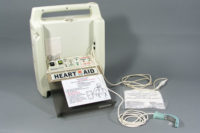While choosing a defibrillator and setting up your AED program require diligence, a few simple steps will help you maximize your program’s effectiveness and ensure it will perform should the need arise.
Championing: One of the most critical elements for success with your company’s AED program is to have an internal champion. It doesn’t have to be you. Ask for a volunteer to help you promote and educate your co-workers. See if one of your employees has had a personal or family experience with SCA and is willing to help promote the program internally.
Elements of successful championing include:
1) Informational brochure about your AED program. It should include information on what defibrillators are, how they work, where they are located and how to sign up to join your internal emergency response team
2) Annual review of Emergency Response Plan (including AED program)
3) Showing Public Service Announcements (PSA) that create awareness of Sudden Cardiac Arrest, Compression Only CPR and AED programs
Recordkeeping/device tracking/maintenance: Although AEDs are easy to set up and install, making sure that they are ready for use is critical. Most devices have warning signals such as loud beeps and lights to notify personnel when the device is not ready for use. However, these methods still require an employee to notice these warning signals.
Use an asset management tracking system to record the expiration dates of your defibrillators’ consumables such as batteries and pads. AED-specific tracking computer programs and externally managed systems can assist you in making sure your device is ready. These systems can also send updated summaries on the state of your AED program and notify you of upcoming scheduled maintenance and training. In the unlikely event that the device is not ready, consider investing in spare pads and batteries.
Integrate your defibrillator maintenance schedule into your safety program schedule that would include fire alert and suppression systems, personal protective equipment (PPE), first aid station and other maintained systems.
Medical direction and regulatory compliance: Most AEDs require a prescription from a physician for purchase and deployment in the workplace. In addition, many states (and even some municipalities) have legal requirements for workplace AED programs. In addition to having a prescription, some legal requirements include medical oversight and review of your maintenance and training programs. Additionally, some EMS systems require the registration of AEDs.
To minimize the legal risk to your company, make sure you are in compliance with all regulatory and legislative requirements for your area.
Training: As a safety and health professional, you understand the importance of first aid training in the workplace, but since approximately 80 percent of cardiac arrests occur at home, the training your employees receive will likely be used to help a family member or neighbor. Since most first aid training programs include CPR and AED elements, make sure your instructor reviews how to use your company’s specific AED. In addition, train employees to recognize when the device is in need of service.
Your employees should know these critical response elements:
1) How to recognize sudden cardiac arrest and how to activate your emergency response plan, including location of the AEDs and activation of the Emergency Medical Services (EMS) system
2) How to perform cardiopulmonary resuscitation (CPR) and if untrained, compression-only CPR
3) How to use the AED
4) How to provide on-going care until EMS arrives
Finally, as time passes since their first aid training occurred, trained employees often lose confidence in their ability to perform these life-saving skills. Many training program providers offer refresher training via the use of on-line programs. Another method of refresher training is conducting drills to respond to sudden cardiac arrest.
Sudden Cardiac Arrest (SCA) drills: The cornerstone of successful AED programs is integrating the use of AEDs into your emergency response drills. These exercises help identify weaknesses in the emergency response system and give employees the opportunity to practice their emergency skills outside the classroom. Make the drill as realistic as possible using a team approach to maximize organizational preparedness.
Key elements of the drill should include:
1) Pre-drill preparation including notifying key communications personnel such as management and switchboard personnel; preparing emergency response equipment such as manikins and AED training devices
2) Notification of the drill for emergency response team members
3) Pre-exercise briefing
4) Simulated SCA Medical Exercise including appropriate response checklists
5) Debriefing
6) Additional exercises or CPR and AED practice for emergency response team members
Successful drills will not only provide you with insight into your AED program but should also serve as educational and motivational experiences for your emergency response team(s).

